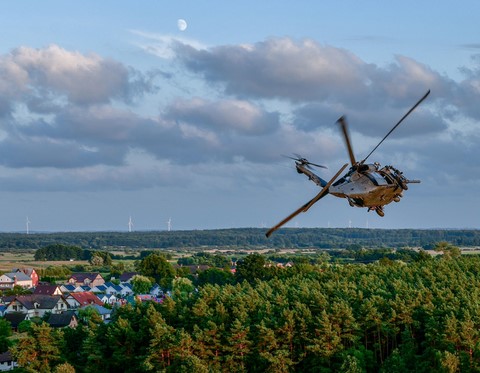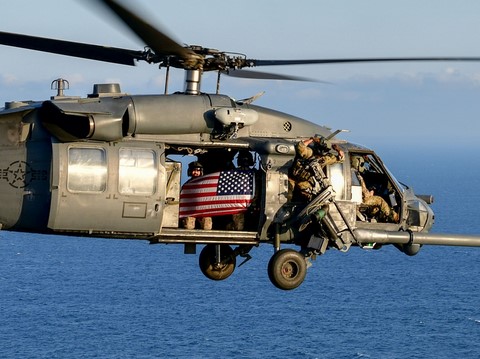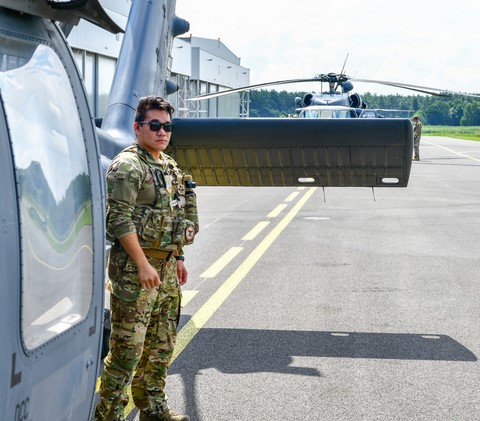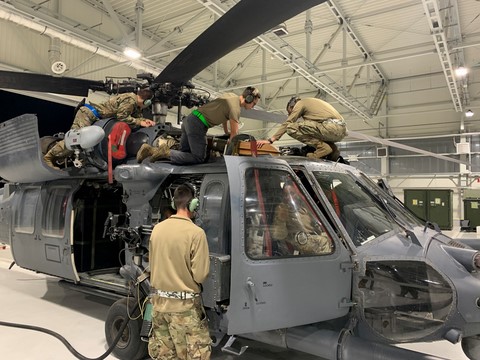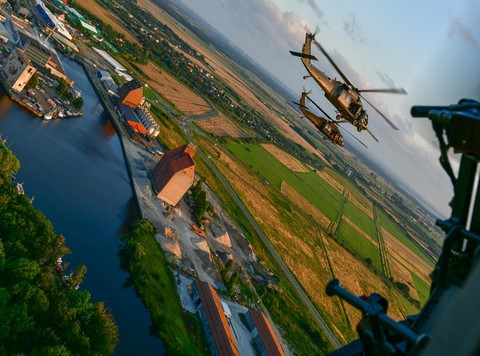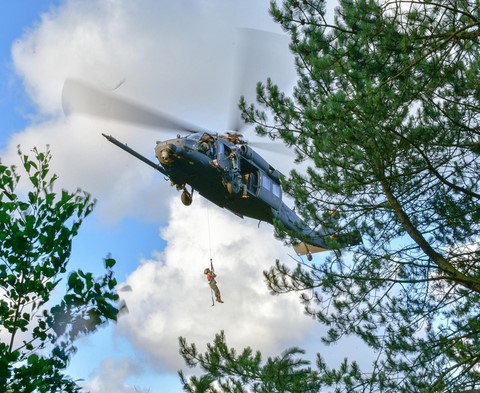56th Rescue Squadron leads Personnel Recovery Training with Polish allies
By Senior Airman Jessica Blair, 31st Fighter Wing / Published August 10, 2021
AVIANO AIR BASE, Italy – -- AVIANO AIR BASE, Italy –
Eighty-eight Airmen assigned to Aviano Air Base conducted a combat integration event, Operation Burza (Storm), in Darlowo, Poland, July 15-31.
Operation Burza focused on personnel recovery in contested maritime and land environments, weapons employment, and integration with Polish special forces.
Thirty-three Airmaen assigned to the 56th Rescue Squadron (RQS) Operations, 45 Airmen assigned to the 56th Helicopter Maintenance Unit (HMU), and 10 Airmen assigned to the, 304th Rescue Squadron (RQS) Guardian Angels, integrated and trained with approximately 40 Polish special forces personnel.
Operation Burza not only gave the 56th RQS the ability to work on personnel recovery techniques, but also allowed them to learn and train with Polish special forces allies.
“Poland is an important ally for us in the region,” said Lt. Col. Michael Kingry, 56th RQS commander. “Our ability to foster relationships with their pilots, crews and operators is key to competing in this region.”
‘Competing,’ in the sense that 30 years ago Poland was under the Soviet sphere of influence and now they’re aligned as one of our most important allies in NATO, explained Kingry. Being on the border with Belarus and Russia makes this an important space for American strategic interests.
“To be able to get this type of training and level of integration with such an important ally is an amazing opportunity and one of the unique aspects of being stationed in Europe,” said Kingry. “The competition we’re taking part in on a daily basis here in Poland is something we’re extremely proud of in the 56th RQS, and something we know will pay dividends in the future.”
Fostering relationships with Polish pilots, crews and operators is vital to safeguarding this region because they learn from each other’s tactics and show that the U.S. Air Force has highly proficient Combat Search and Rescue (CSAR) assets.
“I learned that establishing relationships is very important when it comes to military members stationed in a foreign country,” said U.S. Air Force Staff Sgt. Brandon M. Dimatulac, 56th HMU communication and navigation craftsman. “We have allies for a reason and it is important that we work with and utilize them to prepare for future deployments. Seeing how the polish operate, we can learn from how they execute the CSAR mission and in conjunction we can teach them how we do things.”
The goal is to guarantee the safe return of isolated personnel, whether they be American, Polish, or from another partner nation.
“Working with the Polish has been phenomenal,” said Tech. Sgt. Kayleigh E. Jones, 56th RQS exercises and plans noncommissioned officer in charge. “They have been extremely accommodating to us. We may find ourselves in a situation where we have to use them down range. They’re going to know how we operate and will be able to help us bring a downed pilot home, so his worst day isn’t his last.”
This integration strengthens interoperability and allows familiarization of weapons and defensive systems, while also sharing tactics and techniques with the pilots and aircrew from the Polish special forces.
Additionally, while in Poland, the 56th RQS had the unique opportunity to showcase their pararescuemen skills with 304th RQS. They demonstrated how both HH-60G Pave Hawk crews and their pararescue brethren integrate to provide lifesaving medical treatment to joint and coalition forces, regardless of environment and despite threat with the 304th RQS, a reserve pararescue unit out of Portland, Oregon.
“The most rewarding aspect during Operation Burza was seeing our crew chiefs pull chocks and the birds take off,” said Dimatulac. “For any maintainer it is always rewarding to know that all the hard work, sweat and tears we put in to working on these helicopters pays- off in the end and seeing the bond between maintenance and operators grow over the past two weeks was also a very heart warming and rewarding thing to experience. It is important for us to stay close because when it comes time to operate in the field, we are all we have.”
A HH-60G Pave Hawk assigned to the 56th Rescue Squadron (RQS) executes a defensive maneuver over the Polish countryside during Operation Burza in northern Poland, July, 2021. The 56th RQS worked hand-in-hand with Polish service members to conduct routine training on rescue tactics and techniques. (Courtesy photo)
An HH-60G Pave Hawk assigned to the 56th Rescue Squadron returns from a training mission over the Baltic Sea in support of Operation Burza, July, 2021. This training included the recovery of isolated personnel in a contested maritime environment. (U.S. Air Force photo by Tech. Sgt. Tyler Peterson)
U.S. Air Force Capt. Brian Lee, 56th Rescue Squadron, awaits a mission drop during Operation Burza in northern Poland, July, 2021. While in Poland, the 56th Rescue Squadron aircrew trained to launch at a moment’s notice in response to aircraft shoot-downs or isolating events. (U.S. Air Force photo by Tech. Sgt. Tyler Peterson)
U.S. Air Force maintainers assigned to the 56th Helicopter Maintenance Unit (HMU) work on a HH-60G Pave Hawk flight control incident during Operation Burza in Poland, July, 2021. The 56th HMU Airmen are well-suited to conduct maintenance under austere conditions with limited access to home station support. (Courtesy photo)
Airmen assigned to the 56th Helicopter Maintenance Unit prepare to recover an HH-60G Pave Hawk, during Operation Burza in norther Poland, July, 2021. The 56th Rescue Squadron worked hand-in-hand with Polish service members to conduct routine training on rescue tactics and techniques. (U.S. Air Force photo by Tech. Sgt. Jordan Bell)
Two HH-60G Pave Hawks assigned to the 56th Rescue Squadron fly in formation with a Polish special forces helicopter after executing a direct action mission in the Baltic Sea, July, 2021. Operation Burza allows U.S Air Force personnel recovery forces to operate with Polish partners to ensure the recovery of downed U.S. Air Force Airmen and isolated personnel. (U.S. Air Force photo by Tech. Sgt. Tyler Peterson)
A 56th Rescue Squadron HH-60G Pave Hawk, also known as a “Jolly” conducts a 100-foot hoist recovery of a simulated downed pilot during Operation Burza in northern Poland, July, 2021. Hoist exfiltration allows the HH-60G to recover isolated personnel in a variety of situations that don’t allow for a helicopter landing. (U.S. Air Force photo by Tech. Sgt. Tyler Peterson)
